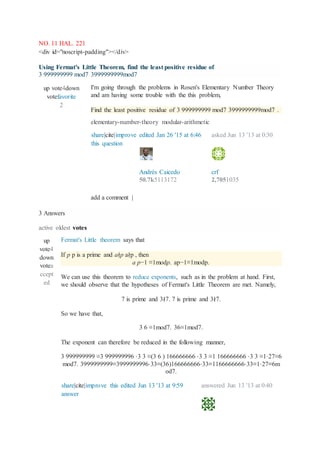Uas teori bil.
- 1. NO. 11 HAL. 221 <div id="noscript-padding"></div> Using Fermat's Little Theorem, find the least positive residue of 3 999999999 mod7 3999999999mod7 up vote4down votefavorite 2 I'm going through the problems in Rosen's Elementary Number Theory and am having some trouble with the this problem, Find the least positive residue of 3 999999999 mod7 3999999999mod7 . elementary-number-theory modular-arithmetic share|cite|improve this question edited Jan 26 '15 at 6:46 Andrés Caicedo 50.7k5113172 asked Jun 13 '13 at 0:30 crf 2,7051035 add a comment | 3 Answers active oldest votes up vote4 down votea ccept ed Fermat's Little theorem says that If p p is a prime and a∤p a∤p , then a p−1 ≡1modp. ap−1≡1modp. We can use this theorem to reduce exponents, such as in the problem at hand. First, we should observe that the hypotheses of Fermat's Little Theorem are met. Namely, 7 is prime and 3∤7. 7 is prime and 3∤7. So we have that, 3 6 ≡1mod7. 36≡1mod7. The exponent can therefore be reduced in the following manner, 3 999999999 ≡3 999999996 ⋅3 3 ≡(3 6 ) 166666666 ⋅3 3 ≡1 166666666 ⋅3 3 ≡1⋅27≡6 mod7. 3999999999≡3999999996⋅33≡(36)166666666⋅33≡1166666666⋅33≡1⋅27≡6m od7. share|cite|improve this answer edited Jun 13 '13 at 9:59 answered Jun 13 '13 at 0:40
- 2. Gamma Function 2,49041543 1 Why used the generalied case when in this cases n n is prime? – Thomas Andrews Jun 13 '13 at 0:49 @ThomasAndrews Yeah, I'm not sure why I went immediately to the generalization. – Gamma Function Jun 13 '13 at 1:00 add a comment | up vote4do wn vote From FLT, 3 6 ≡1(mod7). 36≡1(mod7). Since 999999999=166666666×6+3 999999999=166666666×6+3 we have 3 999999999 ≡3 3 ≡6. 3999999999≡33≡6. share|cite|improve this answer answered Jun 13 '13 at 0:37 Ragib Zaman 25.3k33580 FLT≠ ≠ Fermat's last theorem, but the little one. – vadim123 Jun 13 '13 at 1:01 add a comment | up vote4do wn vote Hint: mod 7: 3 3 ≡−1⇒(3 3 ) 333333333 ≡(−1) 333333333 ≡−1 mod 7: 33≡−1⇒(33)333 333333≡(−1)333333333≡−1 No. 6 hal 236 1. (a) (5 points) Find the last digit of the decimal expansion of 7999,999. (b) (5 points) Find the least positive residue of 21,000,000 modulo 17. Solution: a) This is problem 6.3.6 from the book/Homework We have to study 7 (mod 10). Notice that φ(10) = 4, then, by Euler’s theorem, 74 ≡ 1 (mod 10). On the other hand, 1, 000, 000 is multiplo of 4m, that means that 999, 999 = 4k + 3 for some k ∈ Z. then 7999,999 ≡ 74k+3 ≡ 73 ≡ 9 · 7 ≡ 3 (mod 10). The last digit is 3. This part can be done without using Euler’s theorem, just by checking that 74 ≡ 1 (mod 10). b) This is problem 6.1.12 from the book/Homework
- 3. By Fermat’s little theorem, 216 ≡ 1 (mod 17). Since 16 | 1, 000, 000, we have that 21,000,000 ≡ 1 (mod 17). Just learning based on question page 253 no 6d 2. (a) Find the form of all positive integers satisfying ¿(n) = 10: What is the smallest positive integer for which this is true? (b) Show that there are no positive integers satisfying ¾(n) = 10: Solution: (a) If n = p1 e1 ¢¢¢ pr er ; then ¿(n) = (e1 + 1) ¢¢¢ (er + 1) = 10: Thus9e1 + 14 = 2 and e2 + 1 = 5 (or vice-versa), or e1 + 1 = 10: Thusn has the form p or pq for some primes p and q: The smallest such is 3 ¢ 24 = 48: Since ¾(n) ¸ n + 1 > n for n > 1; it su±ces to compute ¾(n) for n < 10: None equal 10



